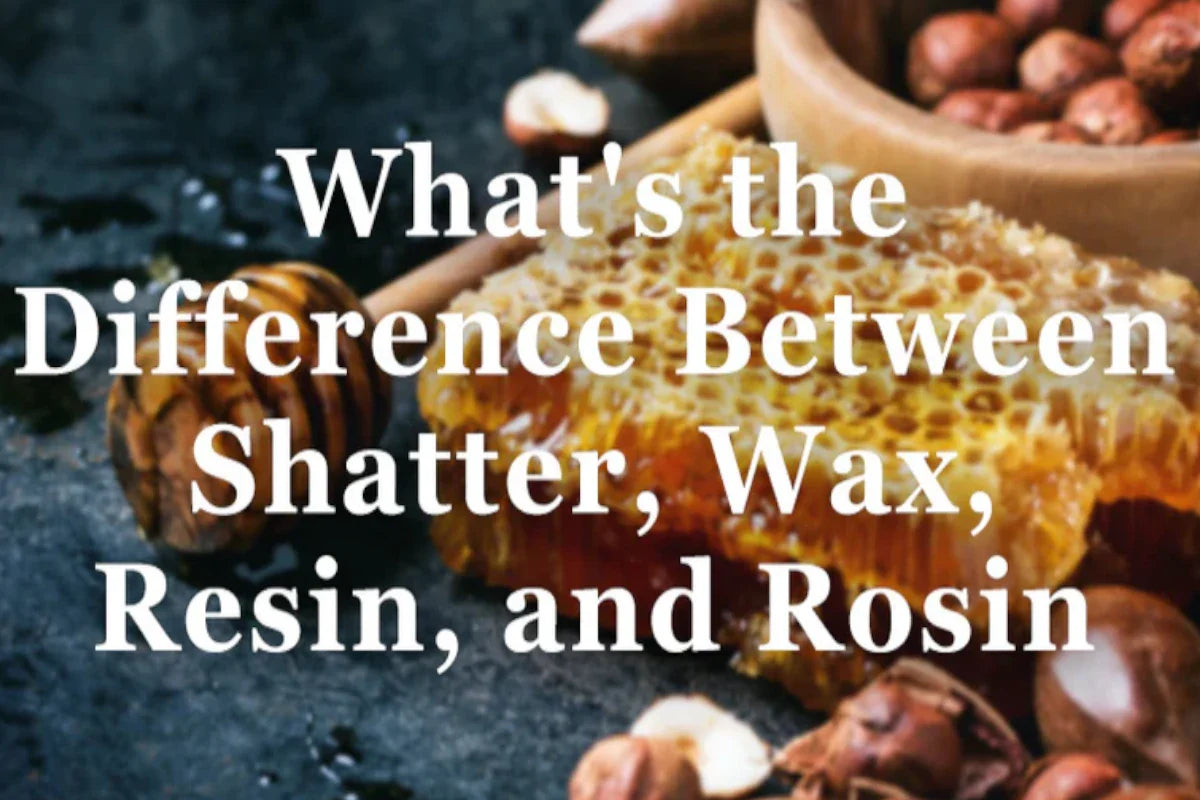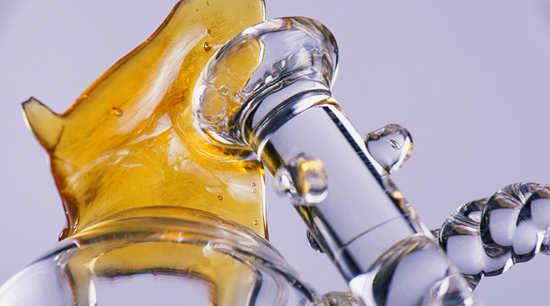Understanding the Different Types of Cannabis Concentrates
The cannabis industry has innovated an impressive array of different types of cannabis concentrates, each offering a unique experience for connoisseurs and patients alike. The diversity in these potent products ranges from oil concentrates , known for their ease of use and purity, to wax concentrates, which boast a nuanced terpene profile. Appealing to those who appreciate the art of extraction, shatter stands out with its glass-like clarity, while hash and resin offer a more traditional form. Advanced forms like distillates achieve high levels of THC, making them sought after for their potency and versatility. In terms of extraction methods, solvent-based techniques such as BHO (butane hash oil) and CO2 extraction are prevalent, whereas solventless options often utilize dry or ice methods to preserve a robust spectrum of cannabinoids and terpenes.
For those seeking the entourage effect, full-spectrum extracts maintain a comprehensive profile of cannabis compounds. As consumers become more sophisticated, the demand for live concentrates that capture the raw essence of the plant has skyrocketed, highlighting the intricate interplay of cannabinoids and terpenes within these various forms of marijuana products.

Exploring Types of Cannabis Extracts and Their Uses
Delving into the world of cannabis extracts offers a panoramic view of the myriad ways THC and other cannabinoids can be concentrated into potent marijuana concentrates.
Among the most popular types, we find cannabis concentrate products tailored to various consumption methods, each providing a unique delivery of the plant's effects. The extraction process is pivotal, often employing solvents like CO2 or BHO (Butane Hash Oil), while solventless techniques also resonate with purists. Smoking, though traditional, makes way for advanced methods such as using a vape or dabbing, which cater to those seeking a clean and high-potency experience. Edibles, on the other hand, offer a discrete and long-lasting delivery of effects, incorporating THC or CBD into consumable products.
Medical users may lean towards concentrates rich in CBD, seeking therapeutic benefits without the psychoactive effects of THC. Cannabis concentrates, rich in cannabinoids and terpenes, carry the essence of the plant's profile, and their usage spans recreational to medicinal, underscoring the versatility and evolution of marijuana products.
How concentrates are consumed
Consuming cannabis concentrates can be done in several ways, each method catering to different preferences for potency and experience.
The most common method is dabbing, which involves using a dab rig—a type of water pipe with a chamber for heating the concentrate on a heated surface called a nail. Vaporizing is another popular method; it uses vape pens specifically designed for concentrates, offering a discreet and portable option. Some users prefer adding concentrates to flower in a joint or a bowl to enhance the potency and flavor of their smoke. Edibles and tinctures also provide alternatives for those seeking longer-lasting effects without inhalation. When consuming concentrates, it's crucial to start with a small amount, especially for beginners, due to the high potency of these products. Additionally, ensuring that the heating element is at the correct temperature is vital; too hot, and you risk burning off the delicate terpenes that enhance flavor and potential therapeutic benefits.
A Comprehensive Guide to Types of Cannabis Concentrates
As cannabis concentrates continue to captivate both the curious and seasoned consumers, understanding the diverse forms these potent products take is essential. Often overshadowed by traditional flower, concentrates offer a full spectrum manifestation of cannabis that can drastically vary in THC and CBD concentrations.
They encapsulate the quintessence of cannabinoids and terpenes, delivering an intensified encounter with the plant's essence. Extraction methods play a pivotal role in the creation of these concentrates, with techniques ranging from solvent-based extraction to solventless methods, such as rosin press. Among these, distillation is yet another method producing high-purity extracts. The resulting resin is the base for various concentrates including shatter, wax, and oil, each with its unique texture and potency level. These marijuana derivatives cater to a myriad of uses, providing a versatile arsenal for therapeutic and recreational engagements.
To navigate this potent landscape, it's imperative to grasp the nuances among the types of cannabis concentrates, fostering a deeper appreciation for their forms and functions within the ever-evolving realm of cannabis culture.
An Overview of Wax Extracts: Properties and Preferences
Wax concentrates stand out among cannabis concentrates for their distinctive texture and potency. A favorite for dabbing, these sticky extracts present a specific set of properties that appeal to seasoned consumers. The allure of wax lies partly in its THC concentration, which delivers a potent experience, and the presence of CBD and terpene profiles that contribute to its therapeutic benefits and aromatic richness.
When discussing preferences, users often cite the robust flavor and immediate effect as reasons for gravitating towards wax. Handling wax concentrates requires dexterity, as their gooey consistency can be less forgiving than other forms of marijuana. Smoking, vaporizing, or dabbing are the preferred methods of consumption, each unlocking the full potential of wax's effects in unique ways.
When considering consumption tips, it's crucial to maintain appropriate temperatures to preserve the delicate terpene profiles that infuse wax with its characteristic essence. Furthermore, cannabis enthusiasts are advised to understand their tolerance levels given the high THC content in wax concentrates, allowing for a controlled and enjoyable experience.
Pros and Cons of concentrates
Pros
-
1. Higher Potency:
- Efficiency : Concentrates contain a much higher level of cannabinoids (THC, CBD) than regular flower, meaning users need less product to achieve the desired effects.
- Stronger Effects : This makes them especially beneficial for medical users who require a high dose of cannabinoids to manage symptoms.
- 2. Purer Product:
- Fewer Combustibles : Because concentrates are processed to extract the cannabinoids and terpenes, they often contain fewer impurities and combustible materials compared to raw cannabis flower.
- 3. Flavor and Experience:
- Enhanced Flavors : Many concentrates, especially those like live resin, preserve the terpenes of the cannabis plant better than dried flowers, providing a superior taste and aroma.
- Varied Experiences : The precise extraction methods allow producers to create products targeting specific effects, flavors, and experiences, catering to personal preferences.
- 4. Discreet and Convenient:
- Ease of Use : Concentrates can be consumed using small, portable devices like vape pens, which produce less odor than smoking flower.
- Portability : Their compact nature makes them easier to transport without the risk of crushing or damage that flowers face.
- 5. Less Smoke:
- Healthier Alternatives : Vaping concentrates produces vapor rather than smoke, which is generally less harsh on the lungs compared to smoking flower.
Cons
-
1. High Potency:
- Overconsumption Risk : The high levels of THC can be too intense, especially for new users, potentially leading to uncomfortable psychoactive experiences.
- Tolerance Issues : Regular use of high-potency concentrates can increase tolerance, necessitating larger amounts to achieve the same effects.
- 2. Cost:
- More Expensive : Generally, concentrates are more expensive than flower due to the complex extraction processes and the higher potency of the product.
- 3. Complexity and Accessibility:
- Equipment Needs : Consuming concentrates often requires additional equipment such as dab rigs, vaporizers, or special pens, which can be an initial barrier for new users.
- Learning Curve : There's a steeper learning curve in terms of handling, dosing, and consuming concentrates compared to traditional flower.
- 4. Legal and Regulatory Issues:
- Inconsistent Legislation : Concentrates may be subject to stricter regulations than flower, limiting their availability and legality in some areas.
- 5. Extraction Concerns:
- Chemical Solvents : Some concentrates are made using chemical solvents like butane or CO2, which can pose health risks if not properly purged from the final product.
- Environmental Impact : The production of concentrates can have a greater environmental impact, particularly those methods involving solvents.
The Spectrum of Oil Concentrates: From THC Richness to Flavor Profiles
Delving into the world of oil concentrates reveals a broad array of options that cater to a multitude of preferences and needs. THC, the psychoactive cannabinoid known for its potency, is a primary component in many concentrates, offering varying degrees of richness that attract those seeking intense effects. Alongside THC, CBD - celebrated for its therapeutic properties - plays a significant role in balancing the psychoactivity and enhancing the health benefits of these cannabis products. Concentrates come in various forms, each characterized by their extraction and distillation techniques, directly influencing the final product's purity and strength.
Full spectrum concentrates are particularly notable as they preserve the terpenes and additional cannabinoids from the original plant, delivering robust flavor profiles and a comprehensive cannabinoid experience. These oil concentrates are not just about the potency; they're also about savoring the essence of cannabis through their aromatic terpenes. The extraction methods used for producing concentrates are as diverse as their forms, with each method affecting the ultimate concentration of cannabinoids and the subtleties of flavor. Whether it's for consumption through inhalation or as an edible, the various types of cannabis concentrates offer a tailored experience catering to the aficionado's palette and potency preferences.
Discovering Wax Concentrates: Texture, Potency, and Consumption Tips
Embarking on the journey of cannabis concentrates, one discovers wax concentrates as a type hailed for its robust texture and notable potency. With the consistency of wax, handling these concentrates requires a specific approach, often involving tools like dab rigs or vape pens. The texture isn't just for aesthetic appeal; it ensures that dabbing or vaping can be done with ease, offering a consistently high-quality experience.
Thanks to their concentrated form, wax concentrates boast a higher THC count than typical flower, alongside a rich array of other cannabinoids and terpenes, enhancing the entourage effect for users. When considering consumption tips, remember that a little goes a long way due to the potency, and temperatures for vaping or smoking must be monitored to preserve the delicate terpene profiles. Cannabis enthusiasts favor these types of cannabis concentrates for their specific attributes, which provide a powerful and tailored experience for both recreational and medicinal users.
By adhering to wise consumption tips, users can enjoy wax concentrates safely, allowing for an immersive exploration of the varied spectrum of cannabis dabbing accessories.
Unveiling the Variety of Cannabis Concentrate Forms
In the expansive world of cannabis concentrates, the various forms present a multitude of options for enthusiasts and medical patients alike. Ranging from the sticky allure of wax to the translucent sheen of shatter, these different forms cater to diverse preferences in potency and consumption methods. Oils, celebrated for their versatility, are often used in vape cartridges or as tinctures, while resin and sauce burst with full-spectrum flavor profiles, rich in both terpenes and cannabinoids. THC and CBD dominate the discourse around concentrates, given their prominence in effects and sought-after medicinal properties.
Then there's hash, a classic concentrate derived from compressed plant material, and distillates, which push the boundaries of purity and potency. Each type of extract, from wax to oil, offers a unique texture and consistency that can influence the user's experience. With such a varied landscape of cannabis concentrates, understanding their distinct forms—each with their signature flavor profiles and spectrum of effects—is essential in appreciating their craft and the artistry behind their creation.
Different Types of Shatter: Clarity, Consistency, and Consumption
Within the realm of cannabis concentrates, different types of shatter stand out due to their glass-like clarity and brittle consistency. Shatter is a type of extract known for its high potency and concentrated levels of THC, often sought after by enthusiasts seeking a powerful experience. Its clarity is a testament to the purity and quality of the concentrate, which comes in varying degrees from translucent to a rich amber hue. This characteristic is intimately connected to the presence of cannabinoids such as THC and CBD, as well as the aromatic terpenes that define its unique flavor profiles.
The consistency of shatter influences its consumption methods; it's typically dabbed or vaped, providing a rapid onset of effects. Consumption via dabbing involves handling small, broken pieces that are vaporized at high temperatures, showcasing the concentrate’s potency and the intricacy of its terpene profiles.
Whether you're new to dabbing or a seasoned consumer, understanding these aspects of shatter can enhance your appreciation for the artistry and science behind the production of cannabis concentrates.

Cannabis Shatter
Texture and Appearance:
- Shatter is known for its brittle, glass-like texture. It's typically clear or has a light amber color, and as the name suggests, it shatters easily when handled.
- The smooth, hard surface is a result of the molecular alignment of cannabinoids and terpenes achieved during the extraction and setting process.
Extraction and Purity:
- Shatter is often made using butane or CO2 extraction methods. It undergoes a meticulous filtration process to remove waxes and fats, resulting in a purer and clearer concentrate.
- The production process involves a single, longer purge of butane hash oil under lower heat and less agitation, preserving the cannabinoids and terpenes in a more stable form.
Potency and Flavor:
- Due to its purity and less disturbed molecular structure, shatter can retain a potent cannabinoid profile and a cleaner terpene flavor, making it highly effective and flavorful.
- The clarity of shatter often indicates a higher purity, which generally means a stronger and clearer psychoactive effect.
Usage:
- Shatter is typically consumed via dabbing. It requires a dab rig or a vaporizer designed for concentrates, which heats the shatter to a high temperature to produce vapor.
- It’s favored by users who prefer a potent and longer-lasting effect.
Cannabis Wax
Texture and Appearance:
- Wax has a more opaque and crumbly texture compared to shatter. It can also appear gooey and is generally less uniform in consistency.
- The texture results from agitation during the extraction process, causing the oil to crystallize and solidify in a less orderly structure.
Extraction and Purity:
- Like shatter, wax is also made using solvent-based extraction techniques like butane or CO2. However, it is agitated during the purging process, which disturbs the molecular alignment, resulting in a cloudy appearance.
- This process does not prioritize preserving the translucent clarity but focuses on flavor and texture, leading to a different kind of purity from shatter.
Potency and Flavor:
- Wax concentrates typically have a rich flavor due to a higher concentration of terpenes, although the potency might be slightly lower than shatter due to the presence of more residual fats and oils.
- The opaque nature of wax does not necessarily indicate lower quality; rather, it highlights a different cannabinoid and terpene balance.
Usage:
- Wax is easier to handle and dose than shatter due to its less brittle consistency. It can be used in dab rigs, vaporizers, and sometimes even mixed with flower in a joint.
- Its ease of use and robust flavor profile makes it a favorite among those who vape or dab regularly.
Live Resin vs. Wax
Live Resin:
- Extraction : Made using fresh cannabis flowers that are frozen immediately after harvest and kept frozen throughout the extraction process, typically using butane or propane. This method preserves the terpenes and cannabinoids better than other methods.
- Characteristics : Tends to have a more fluid consistency and a vibrant, aromatic profile due to the preservation of terpenes.
- Uses : Preferred for its strong flavor and aroma, making it ideal for vaping and dabbing by those who prioritize taste and a full-spectrum cannabinoid experience.
Wax:
- Extraction : Produced using dried and cured cannabis flowers with butane, which is purged out to create a sticky substance.
- Characteristics : Opaque and crumbly or sticky texture. It's less terpene-rich compared to live resin but higher in THC concentration.
- Uses : Commonly used for dabbing due to its high potency and ease of handling with dabbing tools.
Sugar vs. Wax
Sugar:
- Extraction : Similar to wax but with a slightly different post-processing method that allows it to crystallize, giving it a granulated, sugar-like texture.
- Characteristics : Contains a higher level of terpenes than wax, giving it a more robust flavor and aroma.
- Uses : Often used for dabbing and vaping, preferred by users who enjoy a flavorful experience with a potent high.
Wax:
- Extraction & Characteristics : As above.
- Uses : As above, favored for its high potency and straightforward usage in dab rigs and vape pens.
Live Resin vs. Shatter
Live Resin:
- Extraction & Characteristics : As above, noted for its fresh flavor and aromatic profile.
- Uses : As above, sought after for maintaining the true essence of the cannabis plant.
Shatter:
- Extraction : Made using butane extraction and is purged to remove solvents, then allowed to harden into a translucent, glass-like consistency.
- Characteristics : Known for its purity and clarity, with a brittle texture that shatters easily.
- Uses : Popular for dabbing due to its clean, high potency product which delivers a quick, intense effect.
Live Resin vs. Budder
Live Resin:
- Extraction & Characteristics : As above, emphasizing its high terpene content and moist consistency.
- Uses : As above, favored by users who value flavor and a comprehensive cannabinoid profile.
Budder:
- Extraction : Similar to wax but whipped during the purging process to introduce air, giving it a lighter, more malleable texture similar to butter.
- Characteristics : Creamy and easy to handle, with a balance between flavor and potency.
- Uses : Ideal for dabbing and vaping, appreciated for its smooth texture and flavorful hits.
Sugar vs. Resin
Sugar:
- Extraction & Characteristics : As above, crystalline in form with a high terpene content that enhances its flavor.
- Uses : Preferred by those looking for a strong flavor and potent effect in their vaping and dabbing experiences.
Resin (assuming standard resin, not live resin):
- Extraction : Typically extracted using solvents like BHO, without the immediate freezing process used for live resin.
- Characteristics : Less flavorful than live resin or sugar, but potent and effective.
- Uses : Used in a variety of applications from dabbing to incorporation in edibles, valued for its potency and versatility.
Examining the Potency and Purity of THC in Cannabis Concentrates
When delving into the vibrant realm of cannabis concentrates, it's crucial to understand the correlation between THC potency and purity. THC, or tetrahydrocannabinol, is the psychoactive cannabinoid responsible for marijuana's signature high. Different types of concentrates—from waxes to shatter—offer various forms of potency levels, tailored to individual preferences and tolerances.
Connoisseurs seek distillates for their unparalleled purity, often exceeding 90% THC, which are devoid of other cannabinoids and terpenes that constitute a full spectrum experience. The methods for extraction plays a significant role in the quality and consistency of concentrates, influencing both the concentration of cannabinoids and the profile of terpenes. Quality testing is an indispensable practice for ensuring that concentrates meet the required standards for potency and purity, offering peace of mind to users.
However, it's wise to approach potent marijuana concentrate forms with respect, as their intensified THC content can deliver powerful effects. Accordingly, being informed about the different types and potency levels of cannabis concentrates is essential for both new and seasoned enthusiasts navigating this diverse landscape.
The Intricacies of Concentrate Extraction Methods
In the realm of cannabis concentrates, the nuances of concentrate extraction methods are critical for both potency and purity. Utilizing various solvents such as hydrocarbon, CO2, and alcohol, extractors can isolate desirable cannabinoids like THC and CBD, along with the all-important terpenes that contribute to the unique aroma and flavor profiles of marijuana products. Hydrocarbon extraction, often referred to as BHO (Butane Hash Oil), is renowned for its ability to retain a high concentration of terpenes, producing a resin rich in both flavor and potency.
Meanwhile, supercritical CO2 extraction boasts a cleaner and eco-friendlier approach, eliminating solvent remnants and thus assuring high-quality extracts. Advanced techniques such as distillation facilitate the creation of nearly pure THC or CBD concentrations, elevating the efficacy of extracts. More rudimentary solventless methods, relying on physical means like heat and pressure, give rise to wax and resin without the use of external chemical solvents, which is a boon for consumers seeking natural purity. From the equipment employed to the type of solvent chosen, each method influences the final texture, quality, and cannabinoid spectrum of the concentrate, making it essential for users to understand the intricate process to select cannabis concentrates that best align with their preferences and needs.
Ensuring Safe Consumption: Testing and Delivery Equipment for Cannabis Concentrates
Safe consumption of cannabis concentrates is paramount, and it begins with rigorous testing for potency, purity, and quality. Precise testing ensures the identification of cannabinoids levels, including THC, and the aromatic terpenes that define each strain's unique profile. As concentrates come in various forms, from wax to shatter, each with differing levels of concentration, such scrutiny is crucial for consumer safety.
Additionally, the delivery equipment used plays a significant role in the consumption method and safety of the user. Vaping, employing either pens or more sophisticated dab rigs, has become a popular method due to its efficiency and perceived safety compared to the combustion of bongs. However, consumers should be vigilant in researching and procuring quality delivery equipment to mitigate the risks associated with improper use or manufacturing defects. Ensuring the safety of both the extracts and the equipment is vital, as it determines the overall safety and experience of enjoying the multitude of marijuana products available on the market.
A Closer Look at the Different Types of Cannabis Oil Concentrates
Diving into the world of cannabis oil concentrates, connoisseurs and newcomers alike can discover a diverse array of products defined by their unparalleled potency and distinct flavor profiles. THC and CBD emerge as the primary cannabinoids, providing a spectrum of effects and therapeutic benefits. These oil concentrates come in various textures and forms, including the rich viscosity of distillates, often favored for their purity in vaping cartridges.
On the other end, full-spectrum extracts preserve the plant’s comprehensive chemical profile, which includes an ensemble of terpenes and cannabinoids, sought after for their synergistic effects—popularly referred to as the "entourage effect". Each type of concentrate has nuances in usage and preferred delivery methods, be it dabbing equipment for wax concentrates or discreet pens for oils. When discussing potency, it’s not uncommon to encounter extracts with soaring levels of THC; however, this is balanced by products emphasizing CBD for those seeking less psychoactive experiences. Central to these products are the extraction methods that differentiate them, ranging from solvent-based techniques to solventless methods that maintain the plant’s natural properties. Ensuring safe consumption is a paramount concern, hence why testing products for contaminants and proper equipment usage are critical components in the cannabis concentrate experience.
What is the best form of cannabis concentrate?
The best form of cannabis concentrate depends on the user’s preferences and needs. For flavor and aroma, live resin is highly regarded because it preserves more terpenes. For potency and purity, shatter is often preferred due to its high THC content and clear consistency. Those seeking a balance of easy usability and robust flavor might opt for wax or budder . Ultimately, the best concentrate is one that aligns with your specific usage goals and consumption methods.
What are the different cannabis extracts?
Cannabis extracts, often referred to as concentrates, include a variety of products derived from the cannabis plant through extraction processes. Key types include:
- Oil : Versatile and can be used in vape pens, capsules, or edibles.
- Wax : Thick, moldable texture ideal for dabbing.
- Shatter : Hard, glass-like consistency known for its purity and high THC content.
- Live Resin : Made from fresh frozen plants to preserve more terpenes.
- Rosin : Solventless extract pressed from cannabis using heat and pressure.
- Distillate : Highly refined oil typically containing one specific cannabinoid.
What is the difference between the different types of concentrates?
The primary differences between types of cannabis concentrates—such as wax, shatter, resin, and oil—lie in their extraction methods, texture, potency, and flavor profile. Wax is creamy and easy to handle, shatter is hard and clear, indicating high purity. Resin retains a rich terpene profile, enhancing flavor, while oil is versatile, used in edibles and vapes. The choice between them typically depends on the desired intensity of effects, the preferred method of consumption, and the value placed on flavor.
What type of dab gets you the highest?
The type of dab that typically gets you the highest is one containing THC distillate , as it often features THC concentrations of 80% or higher. However, other factors like the presence of other cannabinoids and terpenes can enhance the psychoactive effects through the entourage effect. Shatter and live resin are also potent choices, with shatter being favored for its purity and live resin for its full spectrum of cannabinoids and terpenes. The intensity of the high can also vary based on individual tolerance and consumption method.








